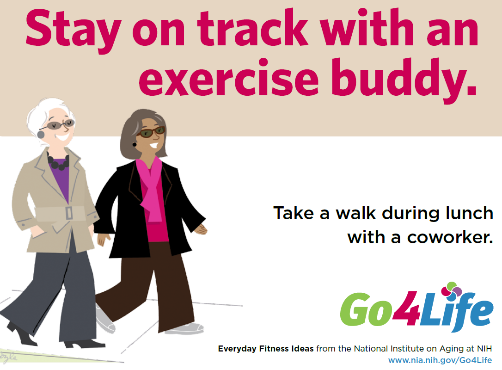 It’s no secret that exercise is good for you and can improve your life in so many ways. The idea of exercise can be daunting for some people, especially if you’ve never done it on a regular basis. You don’t have to go to the gym and lift weights or run a half -marathon to “exercise.” It’s important to keep in mind that many different types of physical activity can be considered exercise and can get you on the path to feeling great every day.
It’s no secret that exercise is good for you and can improve your life in so many ways. The idea of exercise can be daunting for some people, especially if you’ve never done it on a regular basis. You don’t have to go to the gym and lift weights or run a half -marathon to “exercise.” It’s important to keep in mind that many different types of physical activity can be considered exercise and can get you on the path to feeling great every day.
Benefits of physical activity include:
- Increasing your chances of living longer
- Feeling better about yourself
- Decreasing your chances of becoming depressed
- Sleeping well at night
- Moving around more easily
- Having stronger muscles and bones
- Achieving and maintaining a healthy weight
- Being with friends or meeting new people
- Enjoying yourself and having fun!
Consider some new ways to become active such as:
- Volunteering within your community
- Taking group walks around the neighborhood
- Taking up gardening and growing vegetables or flowers
- Doing stretches and chair exercises throughout the day and while watching TV or on the computer.
The idea is to find FUN activities that will keep you moving, active, and engaged. If you decide to start a more rigorous exercise regimen, make sure to ask your doctor first.
Always keep proper hydration in mind, especially when exercising outdoors during the summer heat. Dehydration is a leading cause of hospitalization and serious health problems for older adults. Signs and symptoms of dehydration include headaches, constipation, muscle cramps, dry mouth, sleepiness, and rapid heart rate. It’s important to hydrate yourself with at least eight 8-oz. cups of water during the day. Stay ahead of the game and don’t wait until you’re thirsty to drink… by then, you are already dehydrated.
The National Institutes of Health, National Institutes on Aging recommend making these five tips a priority everyday:
- Try to be physically active for at least 30 minutes on most or all days of the week
- Eat plenty of fruits and vegetables
- Choose foods that are low in added sugars, saturated fats, and sodium
- Pick whole grains and lean sources of proteins and dairy products
- Practice all four types of exercise: endurance, strength, balance, and flexibility
For more information about exercise, hydration, nutrition, and safety for older adults, visit https://go4life.nia.nih.gov/.
- Nutrition and Memory - August 1, 2025
- Exercise Boosts Brain Power - July 1, 2025
- Chronic Inflammation and Dietary Habits - April 2, 2025
